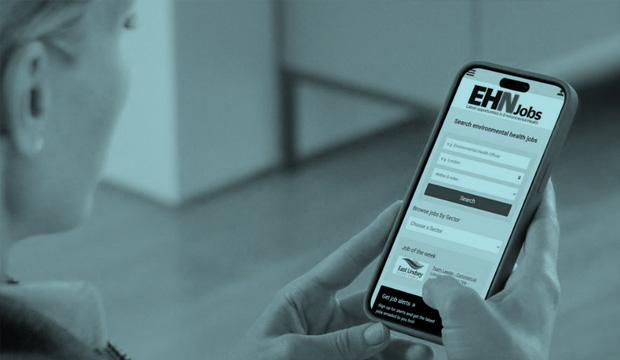Looking for a new role in environmental health?
Whether you're just starting out or ready for your next step, EHN Jobs connects you with the latest opportunities in environmental health across the UK.
Wednesday, 27 May 2020, Chartered CIEH member Dr Lisa Ackerley ('The Hygiene Doctor') and Sterling Crew, Chartered CIEH Fellow and Chair of The Food Authenticity Network

With the hierarchy of control in mind, we must remember that PPE is at the bottom of the list. The first thing to consider is whether you need to leave home at all to go to work, and if so, can you do so while socially distancing.
First things first: workplaces will differ significantly and each employer will need to do a risk assessment to establish potential risks and ensure that workers are protected while at work as much as possible. The protection should include a range of measures, including social distancing, good hygiene and cleaning practices.
However, the use of PPE comes bottom of the list in the hierarchy of control and, in many circumstances outside clinical settings, is not appropriate unless needed for some purpose such as to protect a worker from dust. It is a balance between all of these practices that will provide the best protection for workers.
There is no need for food workers to wear gloves to protect against the virus; it is perfectly acceptable to prepare and handle food with bare hands provided proper hand washing procedures are in place.
In some factory environments and production lines such as airline catering, gloves are used to protect food, but this is in a strict ‘single-use’ setting. In catering, it is very different. In customer-facing roles, it is usually completely useless for staff to wear single-use gloves for many different tasks. They are protecting no one, not even themselves. In some factory environments such as in bakeries, masks are used for dust protection.
The food sector has good food hygiene practices in place including rigorous hand hygiene and food handler fitness to work controls to prevent risk of cross-contamination and spread of infection. In these times, the normal fitness to work procedures, which are in place to ensure that infected workers do not come to work or handle food or food equipment and utensils, will be enhanced by businesses to take into account the risk of a worker bringing coronavirus to the workplace. This is particularly challenging as people may be asymptomatic carriers.
We know it is vital that good standards of personal hygiene are maintained by food handlers to prevent food poisoning as contaminated hands will spread bacteria and viruses around a food preparation area quickly, so these controls are already mainly in place. However, additional hand washing is now needed upon arrival at work, before entering the food environment. This will help to reduce contamination picked up on the way to work.
Food business operators should ensure that staff are aware of the COVID-19 situation and need to complete a risk assessment prior to reopening to show the measures in place to reduce risks. This would follow advice being given by the Government in relation to symptoms, social distancing, restricted movement, self-isolation and travel to work, in addition to any advice given by industry sectors.
Face coverings are usually fabric coverings to cover the nose and mouth. They are not a fitted mask like the ones being used in clinical settings. The Government has advised members of the public that face coverings are generally not compulsory. However, if possible, people are encouraged to wear face coverings in enclosed public spaces where social distancing is not possible or where someone is more likely to come into contact with people they do not normally meet, for example on public transport or in some shops.
Face coverings can help to reduce the spread of the disease and are most effective in protecting others if someone has coronavirus but is not showing any symptoms. For this to work best, everyone needs to wear them in a particular environment, such as on public transport. However, a face covering is not the same as the surgical masks or respirators used as part of PPE by healthcare and other workers and has limited benefit to protect the wearer from others.
The face covering itself could become a fomite – in other words an object that can transmit the virus, particularly if people touch them with dirty hands. This means that they must be worn with caution, put on with clean hands, and taken off with clean hands. Once on, they should not be touched with unclean hands. Laundering or laying aside for 72 hours and storage of re-usable ones and disposal of single-use items are also important considerations.
Everyone who would normally wear a mask in the workplace to protect against dust or fumes should continue to do so. However, in the food sector the wearing of face coverings by food handlers may not be appropriate as other measures should be considered first.
Face coverings could introduce an additional potential food safety risk and may also put the user at greater risk of coronavirus because of the temptation for a food handler to touch and readjust a face mask as they can be very uncomfortable to wear. Adjusting a face mask could bring their hands into contact with their face and risk the spread of Staphylococcus aureus, which may be present in the nose and mouth, onto food via their hands, not to mention any coronavirus that the wearer could be carrying asymptomatically.
Face coverings may be used where members of staff interact with the public as this provides protection from the individual wearing the mask to others, but not as PPE. They may also wish to wear them on the way to work, if transport is crowded. They will need to understand how to put the covering on and how to remove it safety, what to do about storage and laundering (if not single-use). Until further advice is given, this is an optional measure that businesses may wish to use to give customers confidence.
Many Environmental Health Practitioners (EHPs) will have already devised their own risk assessments for the possibility of needing to go into people’s homes. Teams are rightly avoiding this unless absolutely necessary or if there is a very serious hazard that is a danger to health.
The risk assessment should determine the route that will be taken, and the steps in the visit – from arrival through to leaving to be able to assess what can be done to reduce the risks. For example, if there is no one in the house or business, leaving the visit for 72 hours after occupancy would substantially reduce risks. Similarly, if there is a need to enter a food business, for example, then a dialogue should take place between EHP and the owner first to find a safe way of working. For example, the business owner could be asked to stand aside at a two metre distance, or if this is not possible, asked to leave the kitchen whilst the officer inspects.
Government advice is that surgical masks and respirators should continue to be reserved for those who need them to protect against risks in their workplace such as health and care workers and those in industrial settings like those exposed to dust hazards. PPE equipment should be used as per Public Health England’s (PHE) guidance for healthcare and social care settings.
This depends on what kind of contact is expected. For care providers, who will provide close and personal care to someone with possible coronavirus cases or when working closely with those who are shielding or are extremely vulnerable, Table 2 in PHE’s Recommended PPE for primary, outpatient, community and social care by setting, NHS and independent sector provides a useful guide for the type of PPE equipment that should be used.
For now, without the mandatory use of face coverings in public places, unilateral use will not protect the user. Therefore, alternative measures need to be determined, for example distancing and/or plexiglass screens in shops at the payment point or service counter.
When everything has been considered, if it is not safe to proceed then don’t.

Looking for a new role in environmental health?
Whether you're just starting out or ready for your next step, EHN Jobs connects you with the latest opportunities in environmental health across the UK.